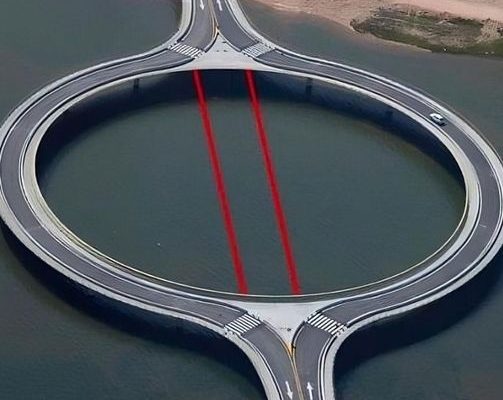The engineering world often gravitates towards sleek, linear designs when it comes to bridges, but one architect dared to challenge the status quo. Rafael Vinoly, a renowned Uruguayan architect, conceived a circular bridge that has captivated the world’s attention since its grand opening in 2016.
The Laguna Garzon Bridge, spanning the entirety of the Laguna Garzon in Uruguay, is a true testament to the power of innovative thinking. Unlike traditional bridges that focus solely on efficiency, this circular structure was designed with a unique purpose in mind – to slow down traffic and encourage drivers to appreciate the stunning natural surroundings.
The concept behind the Laguna Garzon Bridge was to transform a conventional vehicular crossing into an experience that would captivate both locals and visitors alike. Vinoly’s vision was to create a structure that would reduce the speed of cars, providing an opportunity for drivers and passengers to take in the breathtaking panoramic views of the surrounding landscape.
“The concept of the Puente Laguna Garzón was to transform a traditional vehicular crossing into an event that reduces the speed of the cars, to provide an opportunity to enjoy panoramic views to an amazing landscape, and at the same time create a pedestrian place in the center,” Vinoly explained.
Before the construction of the Laguna Garzon Bridge, the only way to cross between the counties of Rocha and Maldonado was by loading cars onto a raft and transporting them individually across the water. This method was not only time-consuming but also lacked the efficiency needed to handle the growing number of vehicles.
The circular design of the bridge has addressed this issue by providing a seamless crossing for up to 1,000 cars per day, significantly improving the commuting experience for both locals and visitors. The bridge’s unique shape, with a radius of 51.5 meters and two straight sections at the entrances measuring 46 meters, has created a captivating visual that has become a landmark in the region.
The Laguna Garzon Bridge is more than just an architectural marvel; it is a reflection of Uruguay’s commitment to sustainable development and its growing tourism industry. The government’s vision for the country has shifted towards a focus on environmental preservation and the promotion of its natural wonders.
 Image Credits: Rafael Vinoly Architects
Image Credits: Rafael Vinoly ArchitectsThe construction of the circular bridge was a strategic move to drive both local and international visitors to the undeveloped coastline of Rocha, a region that had previously been overlooked. By creating a visually stunning and functional structure, the government aimed to attract tourism and showcase the country’s natural beauty.
Circular bridges are not entirely new, but they are typically not designed for road traffic. The Laguna Garzon Bridge, however, stands out as a unique blend of aesthetics and functionality, challenging the traditional approach to bridge design.
“Circular bridges aren’t really rare, but they aren’t meant for road traffic. But contrarily, the Laguna Garzon bridge combines the aesthetics of a circular structure with the key functional aspects of the design,” Vinoly remarked.
The Laguna Garzon Bridge is a testament to the power of innovative thinking and the ability to challenge conventional wisdom. By combining form and function, this circular structure has not only captivated the world but also set a new standard for bridge design.
As we look to the future, the success of the Laguna Garzon Bridge may inspire other architects and engineers to explore unconventional solutions to traditional problems. The bridge serves as a reminder that the most remarkable achievements often come from those who dare to think outside the box and embrace the unexpected.



